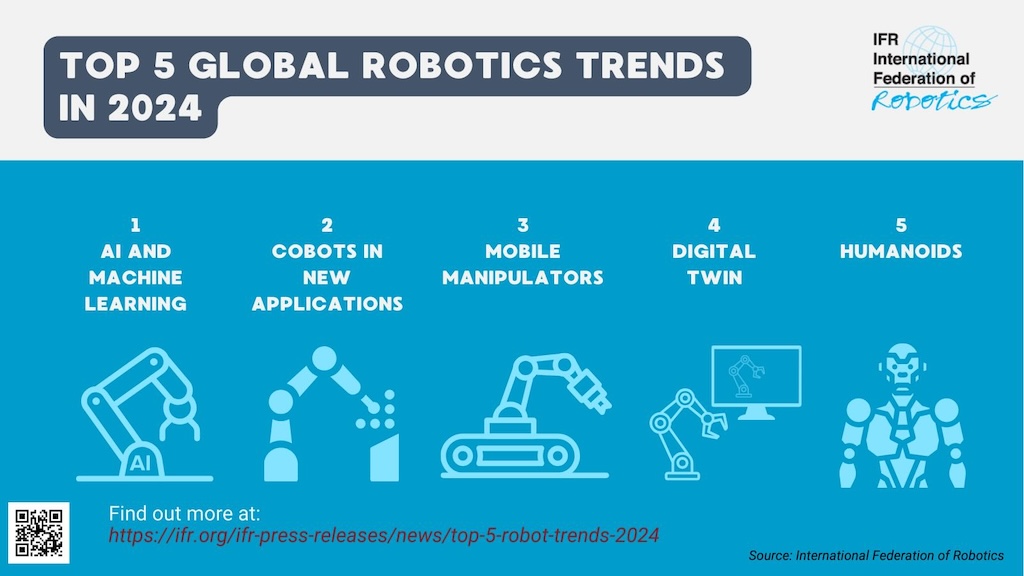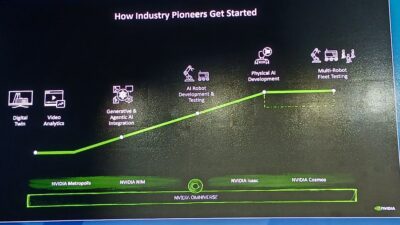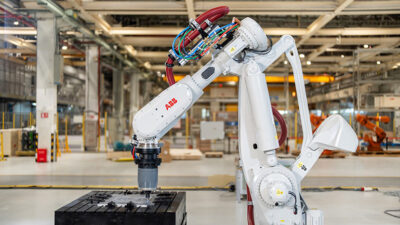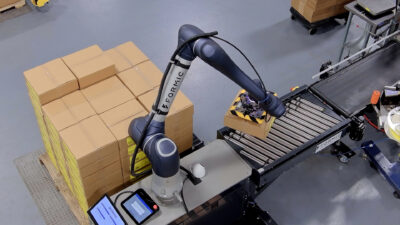Growing demand for robotics is driven by several technological innovations. The five biggest trends in the industry are highlighted.

Industrial robot insights
- The integration of generative AI, exemplified by tools like ChatGPT, is transforming robotics by enabling natural language programming. Predictive AI and machine learning optimize robot performance, enhancing efficiency and reducing costs.
- Collaborative robots (cobots) are diversifying into new applications, addressing labor shortages and complementing traditional industrial robots. Mobile manipulators (MoMas) automate material handling, bridging the gap between digital and physical worlds.
The stock of operational robots around the globe hit a new record of about 3.9 million units. This demand is driven by a number of exciting technological innovations. The International Federation of Robotics reports about the top 5 automation trends in 2024:
1. Artificial intelligence and machine learning (AI/ML)
The trend of using artificial intelligence (AI) in robotics and automation keeps growing. The emergence of generative AI opens-up new solutions. This subset of AI is specialized to create something new from things it’s learned via training, and has been popularized by tools such as ChatGPT. Robot manufacturers are developing generative AI-driven interfaces which allow users to program robots more intuitively by using natural language instead of code. Workers will no longer need specialized programming skills to select and adjust the robot’s actions.
Another example is predictive AI analyzing robot performance data to identify the future state of equipment. Predictive maintenance can save manufacturers machine downtime costs. In the automotive parts industry, each hour of unplanned downtime is estimated to cost $1.3m according to the Information Technology & Innovation Foundation. This indicates the massive cost-saving potential of predictive maintenance. Machine learning algorithms can also analyze data from multiple robots performing the same process for optimization. In general, the more data a machine learning algorithm is given, the better it performs.
2. Cobots expanding to new applications
Human-robot collaboration continues to be a major trend in robotics. Rapid advances in sensors, vision technologies and smart grippers allow robots to respond in real-time to changes in their environment and thus work safely alongside human workers.
Collaborative robot applications offer a new tool for human workers, relieving and supporting them. They can assist with tasks that require heavy lifting, repetitive motions, or work in dangerous environments.
The range of collaborative applications offered by robot manufacturers continues to expand.
A recent market development is the increase of cobot welding applications, driven by a shortage of skilled welders. This demand shows that automation is not causing a labor shortage but rather offers a means to solve it. Collaborative robots will therefore complement – not replace – investments in traditional industrial robots which operate at much faster speeds and will therefore remain important for improving productivity in response to tight product margins.
New competitors are also entering the market with a specific focus on collaborative robots. Mobile manipulators, the combination of collaborative robot arms and mobile robots (AMRs), offer new use cases that could expand the demand for collaborative robots substantially.

3. Mobile manipulators
Mobile manipulators – so called “MoMas” – are automating material handling tasks in industries such as automotive, logistics or aerospace. They combine the mobility of robotic platforms with the dexterity of manipulator arms. This enables them to navigate complex environments and manipulate objects, which is crucial for applications in manufacturing. Equipped with sensors and cameras, these robots perform inspections and carry out maintenance tasks on machinery and equipment. One of the significant advantages of mobile manipulators is their ability to collaborate and support human workers. Shortage of skilled labor and a lack of staff applying for factory jobs is likely to increase demand.
4. Digital twins
Digital twin technology is increasingly used as a tool to optimize the performance of a physical system by creating a virtual replica. Since robots are more and more digitally integrated in factories, digital twins can use their real-world operational data to run simulations and predict likely outcomes. Because the twin exists purely as a computer model, it can be stress-tested and modified with no safety implications while saving costs. All experimentation can be checked before the physical world itself is touched. Digital twins bridge the gap between digital and physical worlds.
5. Humanoid robots
Robotics is witnessing significant advancements in humanoids, designed to perform a wide range of tasks in various environments. The human-like design with two arms and two legs allows the robot to be used flexibly in work environments that were actually created for humans. It can therefore be easily integrated e.g. into existing warehouse processes and infrastructure.
The Chinese Ministry of Industry and Information Technology (MIIT) recently published detailed goals for the country’s ambitions to mass-produce humanoids by 2025. The MIIT predicts humanoids are likely to become another disruptive technology, similar to computers or smartphones, that could transform the way we produce goods and the way humans live.
The potential impact of humanoids on various sectors makes them an exciting area of development, but their mass market adoption remains a complex challenge. Costs are a key factor and success will depend on their return on investment competing with well-established robot solutions like mobile manipulators, for example.
“The five mutually reinforcing automation trends in 2024 show that robotics is a multidisciplinary field where technologies are converging to create intelligent solutions for a wide range of tasks,” said Marina Bill, president of the International Federation of Robotics. “These advances continue to shape the merging industrial and service robotics sectors and the future of work.”
– Edited from an IFR press release by CFE Media and Technology.



